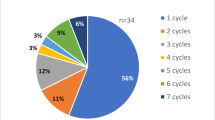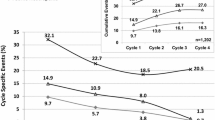Abstract
Background
The aim of this study is to identify factors that increase the occurrence of severe neutropenia (SN) and febrile neutropenia (FN) during docetaxel treatment for castration-resistant prostate cancer (CRPC).
Methods
We retrospectively reviewed 258 courses during the first three cycles among 95 patients. Docetaxel at a dose of 75 mg/m2 was administered every 3 or 4 weeks. Patient background, laboratory data, and bone scan results were collected to assess predictive factors for SN and FN. We defined SN as an absolute neutrophil count (ANC) of <500/mm3 and defined FN as an ANC of <1000/mm3 with a body temperature of >38.3 °C.
Results
The mean age of the patients was 72.6 ± 6.4 years and the mean prostate-specific antigen was 135.4 ± 290.9 ng/ml. During the first three courses of treatment, SN occurred in 72.6 % of patients and FN occurred in 9.5 % of patients. Univariate analysis demonstrated that age ≥75 years (p = 0.002), number of comorbidities ≥1.2 (p = 0.008 and p = 0.006) and previous external beam radiation therapy (EBRT) (p = 0.001) were predictive factors for the development of SN or FN. In multivariate analysis, significant predictors of SN or FN were age ≥75 years (hazard ratio [HR] 5.77; p = 0.004) and previous EBRT (HR 14.5; p = 0.012). According to the subgroup analysis dividing SN and FN separately, multivariate analysis also revealed that age ≥75 years and previous EBRT were also significant predictors for developing SN (HR 5.09; p = 0.023, HR 12.7; p = 0.020, respectively) and for developing FN (HR 5.45; p = 0.042, HR 7.72; p = 0.015, respectively).
Conclusions
Patients aged ≥75 years and with a history of localized radiation therapy are at higher risk for significant neutropenic events and require closer surveillance.


Similar content being viewed by others
References
American Cancer Society (ACS) (2013) Cancer facts and figures 2013. http://www.cancer.org/docroot/STT/stt_0_2003.asp?sitearea=STT&level=1. Accessed Jan 2013
Tannock IF, de Wit R, Berry WR et al (2004) Docetaxel plus prednisone or mitoxantrone plus prednisone for advanced prostate cancer. N Engl J Med 351(15):1502–1512
Petrylak DP, Tangen CM, Hussain MH et al (2004) Docetaxel and estramustine compared with mitoxantrone and prednisone for advanced refractory prostate cancer. N Engl J Med 351(15):1513–1520
de Bono JS, Oudard S, Ozguroglu M et al (2010) Prednisone plus cabazitaxel or mitoxantrone for metastatic castration-resistant prostate cancer progressing after docetaxel treatment: a randomised open-label trial. Lancet 376(9747):1147–1154
Ryan CJ, Smith MR, de Bono JS et al (2013) Abiraterone in metastatic prostate cancer without previous chemotherapy. N Engl J Med 368(2):138–148
Freifeld AG, Bow EJ, Sepkowitz KA et al (2011) Clinical practice guideline for the use of antimicrobial agents in neutropenic patients with cancer: 2010 update by the Infectious Diseases Society of America. Clin Infect Dis 52(4):e56–e93
Smith TJ (2006) 2006 update of recommendations for the use of white blood cell growth factors: an evidence-based clinical practice guideline. J Clin Oncol 24(19):3187–3205
Crawford J, Allen J, Armitage J et al (2011) Myeloid gowth factors. J Natl Compr Cancer Netw 9:914–932
Hurria A, Togawa K, Mohile SG et al (2011) Predicting chemotherapy toxicity in older adults with cancer: a prospective multicenter study. J Clin Oncol 29(25):3457–3465
Soloway MS, Hardeman SW, Hickey D et al (1988) Stratification of patients with metastatic prostate cancer based on extent of disease on initial bone scan. Cancer 61(1):195–202
Naito S, Tsukamoto T, Koga H et al (2008) Docetaxel plus prednisolone for the treatment of metastatic hormone-refractory prostate cancer: a multicenter Phase II trial in Japan. Jpn J Clin Oncol 38(5):365–372
Nishimura K, Nonomura N, Hashine K et al (2013) Prolonged treatment with three-weekly docetaxel plus daily prednisolone for metastatic castration-resistant prostate cancer: a multicenter, phase II, open-label, non-comparative, extension study in Japan. Int J Clin Oncol 18(2):306–313
Laskey RA, Poniewierski MS, Lopez MA et al (2012) Predictors of severe and febrile neutropenia during primary chemotherapy for ovarian cancer. Gynecol Oncol 125(3):625–630
Hosmer W, Malin J, Wong M (2011) Development and validation of a prediction model for the risk of developing febrile neutropenia in the first cycle of chemotherapy among elderly patients with breast, lung, colorectal, and prostate cancer. Support Care Cancer 19(3):333–341
Kellokumpu-Lehtinen PL, Hjalm-Eriksson M, Thellenberg-Karlsson C et al (2012) Toxicity in patients receiving adjuvant docetaxel + hormonal treatment after radical radiotherapy for intermediate or high-risk prostate cancer: a preplanned safety report of the SPCG-13 trial. Prostate Cancer Prostatic Dis 15(3):303–307
Shiozawa T, Tadokoro JI, Fujiki T et al (2013) Risk factors for severe adverse effects and treatment-related deaths in Japanese patients treated with irinotecan-based chemotherapy: a postmarketing survey. Jpn J Clin Oncol 43(5):483–491
Jiang N, Chen XC, Zhao Y (2013) Analysis of the risk factors for myelosuppression after concurrent chemoradiotherapy for patients with advanced non-small cell lung cancer. Support Care Cancer 21(3):785–791
Intragumtornchai T, Sutheesophon J, Sutcharitchan P et al (2000) A predictive model for life-threatening neutropenia and febrile neutropenia after the first course of CHOP chemotherapy in patients with aggressive non-hodgkin’s lymphoma. Leuk Lymphoma 37(3–4):351–360
Acknowledgments
This work was supported in part by a Grant-in-Aid for Young Scientists (Start-up # 24890230 to Takeo Kosaka) from the Ministry of Education, Culture, Sports, Science, and Technology of Japan. The funders had no role in the study design, data collection and analysis, decision to publish, or preparation of the manuscript.
Conflict of interest
The authors declare that they have no conflict of interest.
Author information
Authors and Affiliations
Corresponding author
Electronic supplementary material
Below is the link to the electronic supplementary material.
About this article
Cite this article
Shigeta, K., Kosaka, T., Yazawa, S. et al. Predictive factors for severe and febrile neutropenia during docetaxel chemotherapy for castration-resistant prostate cancer . Int J Clin Oncol 20, 605–612 (2015). https://doi.org/10.1007/s10147-014-0746-7
Received:
Accepted:
Published:
Issue Date:
DOI: https://doi.org/10.1007/s10147-014-0746-7




